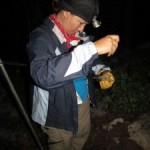‘What!? No more margaritas!?’ Emma Gomez, a doctoral student in Texas A&M University’s wildlife and fisheries sciences department at College Station, is doing her best to keep that from happening.
Gomez is studying the Mexican long-nosed bat, an endangered night-flier that pollinates the agave plant used to make tequila, the key ingredient in margaritas. Her efforts to save the bat just won her the Global Biodiversity Information Facility Young Researcher Award for a doctoral student, according to Dr. Thomas Lacher, a wildlife expert and Gomez’s major professor.
Lacher co-chairs the International Union for the Conservation of Nature Small Mammal Specialist Group and is also a member of the union’s Red List Committee of globally endangered species.
“The Global Biodiversity Information Facility, based in Denmark, is the database of all natural history collections worldwide,” Lacher said. “This is a major international award, selected from applicants all over the world who have been recognized by their respective national biodiversity agencies–Mexico in Emma’s case.”
Lacher said Gomez was also just awarded an American Society of Mammalogists Latin American Field Research Grant at that organization’s annual meeting where she was the top-ranked applicant.
“Specifically, Emma is pursuing research to clarify the conservation status of a bat species of economic importance, one of the pollinators of the agaves used for not only making tequila and mescal, but also as a source of food and fiber,” Lacher said. “She’s also investigating the long-term impacts of climate change on this key pollination interaction. Her research is forging new insights into the ecosystem services provided by biodiversity and the impacts of human activities on these economically important interactions.”
In her study, Gomez points out that the Mexican long-nosed bat, Leptonycteris nivalis, is a migratory species found from central Mexico to the southwestern U.S.. Its range varies from pine-oak and deciduous forest to desert scrub. It’s currently listed as endangered by the U.S. Fish and Wildlife Service and the conservation union.
Gomez said female bats follow the agave bloom as it progresses north from Mexico into the U.S. Paniculate agaves have pollination systems adapted to higher levels of nighttime nectar production which favor nocturnal flower visitors; the bats in particular. The nectar-feeding bats ensure cross-pollination in the agave and thus enhance the plants’ genetic diversity and increase its stability in deserts, scrublands and even subtropical forests.
The migration of long-nosed bats can be considered an endangered phenomenon because of its complexity, her study notes. Saving the species will require protecting the bats’ roost and foraging sites and the environments along their migratory route. However, not much is known about their roosting sites or the status and threats of the agave populations along that migratory route.
“I’m studying the bats’ foraging and roosting sites and identifying threats to key agave conservation sites in its northern range, in particular southwestern Texas, specifically the Big Bend region, and on sites in the states of Coahuila and Nuevo Leon in Mexico.
“My project will provide data for on-the-ground conservation actions to ensure the continuity of this endangered bat and the critical pollination services it provides.”
Gomez said that identifying sites critical to the survival of this migratory species is the first step in establishing a cooperative management and conservation effort between the U.S. and Mexico.
Her work may also very well be the key to saving many a future Texas “happy-hour” as well.
To learn more about IUCN see: http://www.iucn.org/species .

